跨国公司中的文化差异与冲突
跨国公司文化冲突的经典案例

以下是一些具体案例,展示了跨国公司在不同文化环境下遇到的冲突:1. Walmart在德国的失败:Walmart是一家美国零售巨头,试图进入德国市场。
然而,他们的管理风格与德国员工的期望存在冲突。
德国员工普遍享受高福利和工会保护,而Walmart采用了美国式的低薪、灵活工时和强调效率的经营模式。
这导致了员工不满、罢工和声誉受损,最终Walmart在德国市场失败撤退。
2. HSBC收购汇丰银行案例:HSBC是一家英国跨国银行,收购了汇丰银行,使其成为亚洲最大的银行之一。
然而,这次收购带来了文化冲突。
汇丰银行注重亚洲文化价值观、尊重长辈和高度谨慎,而HSBC则更注重效率、规范和快速决策。
这导致了管理层和员工之间的矛盾,需要时间来适应和融合两种文化。
3. Google在中国的争议:Google是一家美国科技巨头,试图进入中国市场。
然而,Google与中国政府在言论自由和信息审查等方面存在冲突。
中国政府要求Google过滤搜索结果,以符合其审查要求,但这与Google强调的开放和信息自由原则相悖。
最终,Google选择退出中国市场,因为他们无法妥协这种文化冲突。
4. McDonald's在印度的适应性挑战:McDonald's是一家美国快餐连锁企业,进入印度市场时面临了饮食习惯和文化差异的挑战。
印度人普遍信奉印度教,其中有许多人是素食者,而McDonald's主打的是含有牛肉成分的汉堡包。
为了适应印度文化,McDonald's在印度推出了纯素餐单,并针对当地口味和食材进行了调整。
5. Coca-Cola与可口可乐之争:Coca-Cola是一家美国饮料公司,进入中国市场时面临与本土品牌可口可乐的竞争。
尽管Coca-Cola在全球范围内很成功,但在中国,本土品牌可口可乐更符合中国消费者的口味和文化偏好。
这个案例突出了在本土市场中,跨国公司需要了解并适应当地文化和消费者需求的重要性。
跨国公司的文化差异问题分析与整合策略 (3)

跨国公司的文化差异问题分析与整合策略一、引言随着全球化的加速发展,跨国公司在全球范围内开展业务已成为常态。
然而,由于不同国家和地区存在着巨大的文化差异,这给跨国公司带来了一系列的挑战和难题。
本文将对跨国公司的文化差异问题进行深入分析,并提出相应的整合策略。
二、跨国公司面临的文化差异问题1. 语言与沟通障碍:不同国家和地区有着不同的语言习惯和表达方式,这往往成为跨国公司沟通和协作的一大阻碍。
语言障碍会导致误解、信息传递不畅以及效率低下等问题。
2. 价值观与信仰冲突:不同文化背景下的人们对于价值观、道德观和信仰有着各自独特的理解和追求。
当这些差异直接冲突时,可能导致团队之间产生分歧和摩擦,甚至影响到公司整体运营。
3. 行为规范与礼仪习惯:每个国家和地区都有着自己的行为规范和礼仪习惯。
如果没有了解并尊重对方文化的特点,可能会因为无意间触犯对方的敏感点而引发负面情绪。
4. 组织结构与决策方式:不同的文化背景会直接影响到跨国公司的组织结构和决策方式。
有些国家更注重集体主义,而另一些国家则倾向于个人主义。
这种差异可能会导致公司运营方式的分歧。
5. 工作态度与效率观念:不同文化背景下的人们对待工作的态度和效率观念也存在差异。
一些国家强调慢工出细活,而另外一些国家则追求效率至上。
这种差异可能因为各自理解问题而带来合作上的困难。
三、跨国公司整合策略1. 文化理解与尊重:在实施任何整合策略之前,跨国公司应该首先进行深入的文化了解,并将其融入到组织战略中。
尊重和欣赏不同文化背景带来的多样性是实现整合目标的关键。
2. 跨文化培训与交流:为跨国员工提供跨文化培训和交流机会是解决文化差异问题的有效途径。
通过了解对方的价值观、行为规范和工作习惯,可以减少误解并促进团队之间的合作。
3. 合理调整组织结构:根据不同国家和地区的文化特点,适当调整公司的组织结构是推动整合的重要手段。
可以借鉴各国经验,在组织层面上实现文化融合和协调。
跨国公司与文化冲突

跨国公司与文化冲突随着全球化的发展,跨国公司在全球范围内的影响力越来越大。
然而,由于不同国家和地区的文化差异,跨国公司在进入新市场时常常面临文化冲突的挑战。
本文将探讨跨国公司与文化冲突的原因、影响以及解决方法。
一、文化冲突的原因1.价值观差异:不同国家和地区的人们对于价值观的理解和追求存在差异。
例如,西方国家注重个人主义和自由,而亚洲国家则更加强调集体主义和家庭观念。
这种价值观的差异可能导致跨国公司在管理和决策方面产生冲突。
2.语言障碍:语言是文化的重要组成部分,不同国家和地区的语言差异可能导致沟通障碍。
跨国公司在进行业务洽谈、员工培训和团队合作时,语言障碍可能成为一大挑战。
3.习俗和礼仪差异:不同国家和地区的人们在习俗和礼仪方面存在差异。
例如,西方国家的商务会议通常注重效率和直接表达,而亚洲国家则更加注重面子和尊重。
这种差异可能导致跨国公司在商务交流和合作中产生冲突。
二、文化冲突的影响1.员工不适应:文化冲突可能导致员工在新的文化环境中感到不适应。
他们可能无法理解和接受新的价值观、习俗和礼仪,从而影响他们的工作效率和团队合作。
2.沟通障碍:文化冲突可能导致沟通障碍,影响跨国公司内部和外部的沟通效果。
员工之间的沟通可能因为语言和文化差异而产生误解和冲突,从而影响工作效率和团队合作。
3.业务失败:文化冲突可能导致跨国公司在新市场的业务失败。
如果跨国公司无法理解和适应当地的文化差异,他们的产品和服务可能无法满足当地消费者的需求,从而导致业务失败。
三、解决文化冲突的方法1.文化敏感培训:跨国公司可以为员工提供文化敏感培训,帮助他们理解和适应新的文化环境。
培训内容可以包括当地的价值观、习俗和礼仪,以及如何进行有效的跨文化沟通。
2.多元化团队建设:跨国公司可以建立多元化的团队,将来自不同文化背景的员工组合在一起。
这样可以促进不同文化之间的交流和理解,减少文化冲突的发生。
3.灵活的管理策略:跨国公司在管理和决策方面需要灵活应对不同文化的差异。
跨国公司中文化冲突的处理方法

跨国公司中文化冲突的处理方法
一、跨国公司中文化冲突的处理方法
在当今全球化的时代,跨国公司越来越多地面临着不同文化之
间的冲突。
这些文化冲突可能会影响到公司的运作和员工的工作效率。
因此,了解并处理这些文化冲突是至关重要的。
下面将介绍一
些处理跨国公司中文化冲突的方法。
首先,建立开放和包容的沟通渠道是解决文化冲突的关键。
员
工应该被鼓励分享他们的文化背景和观点,而不是被要求完全融入
到主流文化中。
通过促进不同文化之间的交流和理解,可以减少误
解和冲突的发生。
其次,培训员工跨文化沟通技能也是至关重要的。
员工应该了
解不同文化之间的差异,包括语言、礼仪、价值观等方面。
他们应
该学会尊重和包容不同文化,并学会在跨文化环境中有效地沟通和
合作。
另外,建立一个多元化和包容性的工作环境也可以帮助减少文
化冲突。
公司应该重视员工的多样性,包括不同的文化背景、性别、种族等。
通过促进多元化和包容性,可以创造一个更加和谐和融洽
的工作氛围。
最后,跨国公司应该制定明确的文化融合政策和流程。
这些政
策和流程应该包括如何处理文化冲突、如何促进文化融合等方面。
公司领导应该积极参与并支持这些政策的执行,确保文化冲突得到
及时和有效地解决。
总的来说,处理跨国公司中文化冲突需要全员参与和共同努力。
通过建立开放的沟通渠道、培训员工跨文化沟通技能、建立多元化
和包容性的工作环境以及制定明确的文化融合政策,可以有效地减
少文化冲突的发生,提高公司的绩效和员工的工作满意度。
跨文化冲突案例

跨文化冲突案例在当今全球化的时代,跨文化冲突日益成为一个重要的议题。
不同文化之间的价值观、信仰、习俗和行为方式的差异,常常会导致冲突和误解。
本文将通过一个真实的案例来探讨跨文化冲突的原因、影响和解决方法。
案例描述:在一家跨国公司中,来自不同国家的员工经常会因为文化差异而产生冲突。
比如,美国员工习惯于直接表达自己的意见,而中国员工则更倾向于委婉地表达。
这种沟通方式的差异经常导致误解和紧张关系。
此外,公司在安排工作任务和时间管理上也存在差异,美国员工更注重效率和个人成就,而中国员工更注重团队合作和集体利益。
这些差异导致了工作效率的下降和团队合作的困难。
原因分析:跨文化冲突的根源在于不同文化之间的差异。
这些差异可能来自于价值观、语言、宗教信仰、社会习俗等方面。
当人们在工作和生活中遇到这些差异时,往往会产生不适和冲突。
此外,对于跨文化冲突的认识不足也是导致冲突的原因之一。
许多人对于不同文化的了解停留在表面,缺乏深入的交流和理解,容易产生误解和偏见。
影响分析:跨文化冲突对个人和组织都会产生负面影响。
在个人层面,跨文化冲突会导致情绪压力增加、自我认同感下降、工作效率降低等问题。
在组织层面,跨文化冲突会影响团队合作、工作效率和企业形象,甚至可能导致员工流失和业绩下滑。
解决方法:要解决跨文化冲突,首先需要加强跨文化意识和交流。
员工应该尊重和理解不同文化的差异,学会从对方的角度去思考问题。
其次,建立跨文化沟通机制和培训体系,帮助员工提高跨文化沟通能力和解决冲突的能力。
此外,公司也可以制定跨文化管理政策,为员工提供文化适应的支持和帮助,营造一个和谐的工作环境。
结论:跨文化冲突是全球化时代不可避免的问题,但通过加强跨文化意识、加强跨文化交流和建立有效的解决机制,是可以有效化解和预防跨文化冲突的。
希望通过本文的案例分析和解决方法的探讨,能够帮助更多的人更好地应对跨文化冲突,促进跨文化交流与合作的发展。
跨国公司在本土化过程中的文化冲突
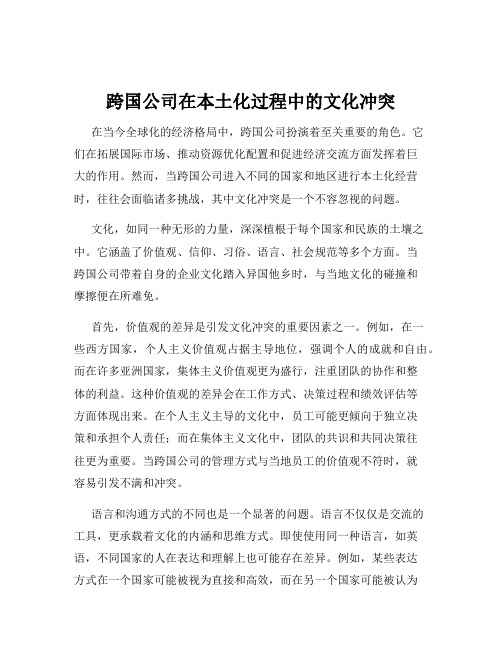
跨国公司在本土化过程中的文化冲突在当今全球化的经济格局中,跨国公司扮演着至关重要的角色。
它们在拓展国际市场、推动资源优化配置和促进经济交流方面发挥着巨大的作用。
然而,当跨国公司进入不同的国家和地区进行本土化经营时,往往会面临诸多挑战,其中文化冲突是一个不容忽视的问题。
文化,如同一种无形的力量,深深植根于每个国家和民族的土壤之中。
它涵盖了价值观、信仰、习俗、语言、社会规范等多个方面。
当跨国公司带着自身的企业文化踏入异国他乡时,与当地文化的碰撞和摩擦便在所难免。
首先,价值观的差异是引发文化冲突的重要因素之一。
例如,在一些西方国家,个人主义价值观占据主导地位,强调个人的成就和自由。
而在许多亚洲国家,集体主义价值观更为盛行,注重团队的协作和整体的利益。
这种价值观的差异会在工作方式、决策过程和绩效评估等方面体现出来。
在个人主义主导的文化中,员工可能更倾向于独立决策和承担个人责任;而在集体主义文化中,团队的共识和共同决策往往更为重要。
当跨国公司的管理方式与当地员工的价值观不符时,就容易引发不满和冲突。
语言和沟通方式的不同也是一个显著的问题。
语言不仅仅是交流的工具,更承载着文化的内涵和思维方式。
即使使用同一种语言,如英语,不同国家的人在表达和理解上也可能存在差异。
例如,某些表达方式在一个国家可能被视为直接和高效,而在另一个国家可能被认为是粗鲁和无礼。
此外,非语言的沟通方式,如肢体语言、眼神交流等,在不同文化中也可能有不同的含义。
这些差异如果不被理解和重视,很容易导致误解和冲突。
宗教和信仰的差异同样会对跨国公司的本土化进程产生影响。
宗教在许多国家和地区是人们生活的重要组成部分,它影响着人们的价值观、道德观和行为准则。
例如,在一些宗教氛围浓厚的国家,工作时间和节假日的安排可能需要考虑宗教活动的需求。
如果跨国公司对此不够尊重和适应,就可能引发当地员工和社会的反感。
风俗习惯的不同也是文化冲突的一个表现方面。
比如,在饮食方面,不同国家有不同的偏好和禁忌。
如何应对跨国公司的文化冲突

如何应对跨国公司的文化冲突在当今全球化的背景下,跨国公司的兴起不可避免地带来了文化冲突的问题。
如何应对跨国公司的文化冲突,成为了各企业需要解决的重要课题。
本文将探讨如何应对这一挑战,以确保跨国公司的文化融合与成功发展。
一、了解不同文化间的差异解决跨国公司的文化冲突首先要从了解不同文化间的差异入手。
不同国家和地区之间的文化差异体现在语言、宗教、价值观、礼仪等多个方面。
企业应充分了解目标市场或目标国家的文化特点,包括其历史背景、价值观以及行为方式。
只有真正了解不同文化之间的差异,才能够有针对性地应对文化冲突。
二、建立文化交流渠道为了促进文化融合,跨国公司需要建立起文化交流的渠道。
可以通过组织员工文化交流活动、设置跨文化培训课程等方式,让员工们能够更好地了解和接纳其他文化,增强彼此的沟通与理解能力。
此外,企业还可以通过定期举办文化庆典、组织文化交流团队等措施,进一步促进不同文化间的交流与融合。
三、打破文化壁垒,建立共同价值观文化冲突的根源往往在于不同文化之间存在着不同的价值观。
为了应对跨国公司的文化冲突,企业需要打破文化壁垒,建立共同的价值观。
可以通过制定企业的核心价值观,使员工们能够共同遵循,摒弃个人主义,形成团队合作的文化氛围。
此外,企业还可以通过晋升制度、奖惩机制等方式,促使员工在行为和决策中更加注重整体利益。
四、培养跨文化管理人才面对跨国公司的文化冲突,企业需要培养具备跨文化管理能力的人才。
这些人才应具备全球化的眼光和跨文化的敏感度,能够在不同文化环境中适应和运作。
企业可以通过选拔和培训,提升员工跨文化沟通与协作的能力,减少文化冲突的发生。
同时,企业也可以引进一些具有跨文化管理经验的专业人才,为对外业务提供支持和指导。
五、积极倡导文化包容与融合在应对跨国公司的文化冲突时,企业应积极倡导文化包容与融合。
对于不同文化之间的差异,企业要通过多元文化教育和宣传,加强员工对其他文化的理解和尊重。
同时,企业还可以通过积极参与当地社会公益事业,促进本土文化的传承和发展,进一步提升企业的社会形象与认同度。
跨国企业文化冲突演讲稿

跨国企业文化冲突演讲稿尊敬的各位领导、各位同事:大家好!今天我很荣幸能有机会和大家一起分享关于跨国企业文化冲突的话题。
在当今全球化的时代,跨国企业已经成为了商业世界中不可或缺的一部分。
然而,随之而来的跨国企业文化冲突也成为了一个不容忽视的问题。
首先,让我们来看看跨国企业文化冲突是如何产生的。
在不同国家和地区,人们的价值观、信仰、习俗和习惯都可能有着巨大的差异。
当企业跨越国界,将自己的业务扩展到不同的文化环境中时,不可避免地会遇到这些文化差异。
这些差异可能会导致沟通不畅、理解偏差、决策不一致等问题,甚至会对企业的运营和发展造成严重影响。
其次,让我们来思考一下跨国企业文化冲突会给企业带来什么样的影响。
首先,文化冲突可能会导致员工之间的紧张和矛盾,影响团队的凝聚力和合作效率。
其次,文化冲突也可能会影响企业的形象和声誉,甚至会影响到企业在当地市场的发展。
最重要的是,文化冲突可能会影响到企业的核心价值观和经营理念,导致企业的发展方向受阻。
那么,面对跨国企业文化冲突,我们应该如何应对呢?首先,企业需要重视文化差异,尊重和包容不同的文化习俗和价值观。
其次,企业需要加强跨文化沟通和交流,建立起相互理解和信任的基础。
此外,企业还可以通过开展跨文化培训和教育,增强员工的跨文化意识和能力。
最重要的是,企业需要根据不同的文化环境,灵活调整自己的经营策略和管理模式,以适应当地的文化需求和市场环境。
在全球化的浪潮中,跨国企业文化冲突已经成为了一个不可忽视的问题。
我们需要正视这个问题,采取有效的措施来化解文化冲突,促进企业的和谐发展。
只有在跨文化融合的道路上不断探索和努力,我们才能够打破文化壁垒,实现企业的可持续发展。
谢谢大家!。
跨国公司审计中的文化差异与沟通策略
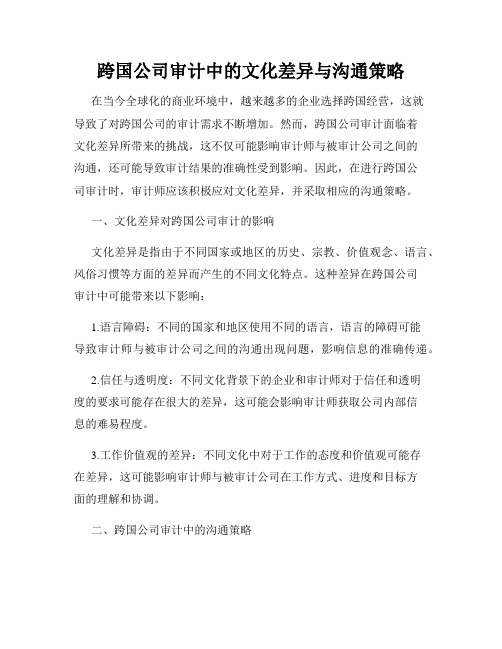
跨国公司审计中的文化差异与沟通策略在当今全球化的商业环境中,越来越多的企业选择跨国经营,这就导致了对跨国公司的审计需求不断增加。
然而,跨国公司审计面临着文化差异所带来的挑战,这不仅可能影响审计师与被审计公司之间的沟通,还可能导致审计结果的准确性受到影响。
因此,在进行跨国公司审计时,审计师应该积极应对文化差异,并采取相应的沟通策略。
一、文化差异对跨国公司审计的影响文化差异是指由于不同国家或地区的历史、宗教、价值观念、语言、风俗习惯等方面的差异而产生的不同文化特点。
这种差异在跨国公司审计中可能带来以下影响:1.语言障碍:不同的国家和地区使用不同的语言,语言的障碍可能导致审计师与被审计公司之间的沟通出现问题,影响信息的准确传递。
2.信任与透明度:不同文化背景下的企业和审计师对于信任和透明度的要求可能存在很大的差异,这可能会影响审计师获取公司内部信息的难易程度。
3.工作价值观的差异:不同文化中对于工作的态度和价值观可能存在差异,这可能影响审计师与被审计公司在工作方式、进度和目标方面的理解和协调。
二、跨国公司审计中的沟通策略为了有效解决跨国公司审计中的文化差异问题,审计师可以采取以下沟通策略:1.多元文化团队:组建一支多元文化的审计团队,其中成员可以具备不同国家和地区的背景和语言能力。
这样可以更好地理解被审计公司的文化差异,有助于加强沟通和理解。
2.语言辅助工具:使用翻译工具和辅助语言工具,帮助审计师和被审计公司之间进行更准确的语言交流。
这包括口译、书面翻译和语音识别等方式。
3.文化敏感性培训:审计团队可以接受关于不同文化背景和价值观念的培训,提高他们对不同文化的敏感性和理解力。
这样有助于避免文化冲突,并更好地应对和解决文化差异带来的问题。
4.有效沟通渠道:建立有效的沟通渠道,可以通过定期的会议、报告以及电子邮件等方式,确保审计师和被审计公司之间的信息交流畅通,避免信息传递中的误解。
5.尊重和包容:尊重和包容对方的文化差异,避免评判和先入为主的观点。
我国跨国公司应对文化差异的案例
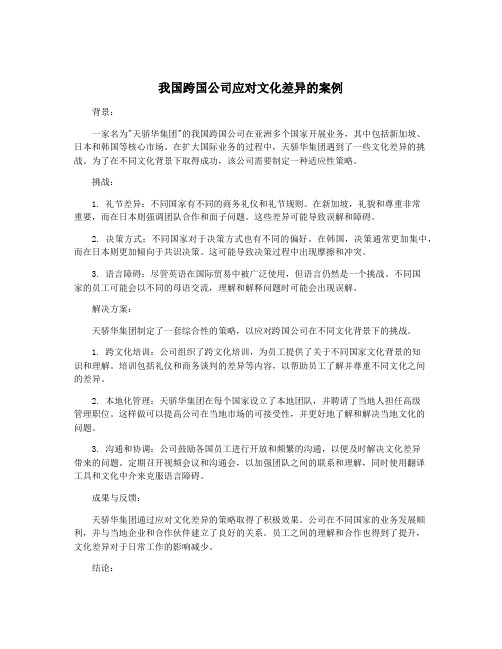
我国跨国公司应对文化差异的案例背景:一家名为"天骄华集团"的我国跨国公司在亚洲多个国家开展业务,其中包括新加坡、日本和韩国等核心市场。
在扩大国际业务的过程中,天骄华集团遇到了一些文化差异的挑战。
为了在不同文化背景下取得成功,该公司需要制定一种适应性策略。
挑战:1. 礼节差异:不同国家有不同的商务礼仪和礼节规则。
在新加坡,礼貌和尊重非常重要,而在日本则强调团队合作和面子问题。
这些差异可能导致误解和障碍。
2. 决策方式:不同国家对于决策方式也有不同的偏好。
在韩国,决策通常更加集中,而在日本则更加倾向于共识决策。
这可能导致决策过程中出现摩擦和冲突。
3. 语言障碍:尽管英语在国际贸易中被广泛使用,但语言仍然是一个挑战。
不同国家的员工可能会以不同的母语交流,理解和解释问题时可能会出现误解。
解决方案:天骄华集团制定了一套综合性的策略,以应对跨国公司在不同文化背景下的挑战。
1. 跨文化培训:公司组织了跨文化培训,为员工提供了关于不同国家文化背景的知识和理解。
培训包括礼仪和商务谈判的差异等内容,以帮助员工了解并尊重不同文化之间的差异。
2. 本地化管理:天骄华集团在每个国家设立了本地团队,并聘请了当地人担任高级管理职位。
这样做可以提高公司在当地市场的可接受性,并更好地了解和解决当地文化的问题。
3. 沟通和协调:公司鼓励各国员工进行开放和频繁的沟通,以便及时解决文化差异带来的问题。
定期召开视频会议和沟通会,以加强团队之间的联系和理解,同时使用翻译工具和文化中介来克服语言障碍。
成果与反馈:天骄华集团通过应对文化差异的策略取得了积极效果。
公司在不同国家的业务发展顺利,并与当地企业和合作伙伴建立了良好的关系。
员工之间的理解和合作也得到了提升,文化差异对于日常工作的影响减少。
结论:以上案例展示了天骄华集团跨国公司应对文化差异的策略。
透过跨文化培训、本地化管理和沟通协调等措施,该公司成功克服了文化差异所带来的挑战,实现了在多个亚洲国家的稳健增长。
跨国公司的文化冲突分析与处理

跨国公司的文化冲突分析与处理随着全球化不断加深,越来越多的企业开始走向跨国化。
在跨国化过程中,企业遇到的文化差异,成为企业面临的重要挑战。
跨国公司的文化冲突分析与处理,是跨国公司成功落地的重要保障。
一、跨国公司文化冲突的原因分析1. 价值观的差异跨国文化冲突最根本的原因是价值观的差异。
不同的文化背景,注定了人们的思考方式、价值观和人际交往模式的不同。
跨国公司在不同的国度和地区开展业务,必须遵守当地的法律法规,同时也要符合当地的文化价值观。
例如,语言因素、饮食习惯、礼仪习惯等,都会对企业的经营和文化交流产生影响。
2. 传统与现代的差异在跨国公司的文化背景下,文化差异也表现出“传统与现代的差异”。
传统文化一方面具有独特的历史背景和文化特色,另一方面也是影响当地人们价值观的源头。
而现代文化则将传统文化转化为现代化价值观,是一种崭新的文化背景。
文化差异带来的文化冲突在跨国公司中,也可以表现为传统与现代的差异。
跨国企业在具有浓厚传统文化特色的国家市场中,需要注意的是尊重传统文化、与当地市场的文化价值观相结合,以此来适应市场环境,推进业务。
3. 企业规模和结构的差异在跨国公司的经营过程中,规模和结构的差异也会导致文化差异的加剧。
在小规模的跨国公司中,公司结构简单、层级少,与其他公司的典型东方公司相比,管理模式相对单一。
而在大型跨国企业中,公司结构复杂、层级较多,高效的沟通是文化冲突中关键的解决手段。
二、跨国公司文化冲突的应对策略在国际贸易和企业境外投资的过程中,不同文化的碰撞会不可避免地产生。
如何正确地应对文化冲突,是企业跨国化经营中的重要问题。
1. 尊重不同文化文化是每个民族的独特标志和文明遗产。
在跨国公司经营中,尊重各个国家和地区不同的文化背景是建立良好合作关系的前置条件。
尊重当地文化,通过礼仪、语言、信仰等方面的了解和沟通,可以降低跨国公司在海外经营中遇到的文化冲突。
2. 适应当地文化适应当地文化是在尊重不同文化的基础上,对特定文化进行深入了解和应用。
跨国公司管理中的文化冲突产生的原因及对策分析

跨国公司管理中的文化冲突产生的原因及对策分析跨国公司管理中的文化冲突是由于不同国家或地区的员工拥有不同的文化背景、价值观、习俗和沟通方式而产生的。
这些文化冲突可能会妨碍团队的协作和沟通,对公司的运营产生负面影响。
因此,解决跨国公司中的文化冲突是一个重要的管理任务。
首先,文化冲突产生的原因如下:1.语言和沟通方式的差异:不同国家和地区使用不同的语言和沟通方式,可能导致误解和沟通障碍。
例如,一些文化强调直接表达意见,而另一些文化更倾向于避免冲突和委婉表达。
2.价值观和信仰的差异:不同国家和地区的人有不同的价值观和信仰体系。
比如,一些文化重视自主性和个人成就,而其他文化更注重集体利益和团队合作。
3.工作方式和习俗的差异:不同国家和地区可能有不同的工作方式和习俗。
例如,一些文化注重工作和责任,而其他文化更注重家庭和休闲。
接下来,我们来探讨解决跨国公司中文化冲突的对策:1.培训和教育:提供文化敏感培训和教育,使员工了解不同文化之间的差异并学习如何尊重和适应这些差异。
这可以帮助员工更好地理解别人的行为和态度。
2.团队建设:通过定期的团队建设活动来促进团队成员之间的相互了解和沟通。
这有助于建立信任和合作关系,减少文化冲突产生的可能性。
3.跨文化领导:任命具有跨文化经验和能力的领导者来管理跨国团队。
这些领导者可以帮助团队成员理解和尊重彼此的差异,并促进跨文化沟通和合作。
4.建立共享价值观和目标:确保跨国团队在共同的价值观和目标下工作。
这可以帮助消除不同文化之间的差异,减少冲突的可能性。
5.促进多元化文化:鼓励员工分享和庆祝自己的文化传统和习俗,以增强团队合作和理解。
6.灵活和开放的沟通:建立一个开放和灵活的沟通渠道,使员工有机会提出和解决文化冲突。
这可以通过定期的反馈和集体讨论来实现。
最后,为了有效解决跨国公司管理中的文化冲突,公司管理层应意识到文化差异的存在,并采取适当的对策。
通过培训、团队建设、跨文化领导以及促进多元化文化和灵活的沟通,管理层可以帮助员工更好地理解和适应不同的文化背景,从而促进团队合作和持续发展。
跨国公司文化差异案例
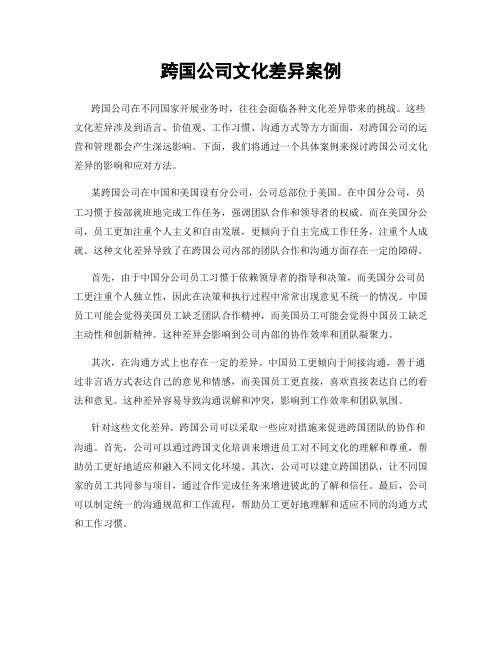
跨国公司文化差异案例跨国公司在不同国家开展业务时,往往会面临各种文化差异带来的挑战。
这些文化差异涉及到语言、价值观、工作习惯、沟通方式等方方面面,对跨国公司的运营和管理都会产生深远影响。
下面,我们将通过一个具体案例来探讨跨国公司文化差异的影响和应对方法。
某跨国公司在中国和美国设有分公司,公司总部位于美国。
在中国分公司,员工习惯于按部就班地完成工作任务,强调团队合作和领导者的权威。
而在美国分公司,员工更加注重个人主义和自由发展,更倾向于自主完成工作任务,注重个人成就。
这种文化差异导致了在跨国公司内部的团队合作和沟通方面存在一定的障碍。
首先,由于中国分公司员工习惯于依赖领导者的指导和决策,而美国分公司员工更注重个人独立性,因此在决策和执行过程中常常出现意见不统一的情况。
中国员工可能会觉得美国员工缺乏团队合作精神,而美国员工可能会觉得中国员工缺乏主动性和创新精神。
这种差异会影响到公司内部的协作效率和团队凝聚力。
其次,在沟通方式上也存在一定的差异。
中国员工更倾向于间接沟通,善于通过非言语方式表达自己的意见和情感,而美国员工更直接,喜欢直接表达自己的看法和意见。
这种差异容易导致沟通误解和冲突,影响到工作效率和团队氛围。
针对这些文化差异,跨国公司可以采取一些应对措施来促进跨国团队的协作和沟通。
首先,公司可以通过跨国文化培训来增进员工对不同文化的理解和尊重,帮助员工更好地适应和融入不同文化环境。
其次,公司可以建立跨国团队,让不同国家的员工共同参与项目,通过合作完成任务来增进彼此的了解和信任。
最后,公司可以制定统一的沟通规范和工作流程,帮助员工更好地理解和适应不同的沟通方式和工作习惯。
通过以上案例和对应的应对措施,我们可以看到,跨国公司在处理文化差异时需要注重员工的文化适应性和跨国团队的协作能力。
只有充分理解和尊重不同文化,才能更好地实现跨国公司的发展目标和持续成功。
跨国公司管理中文化差异导致的沟通障碍及对策研究
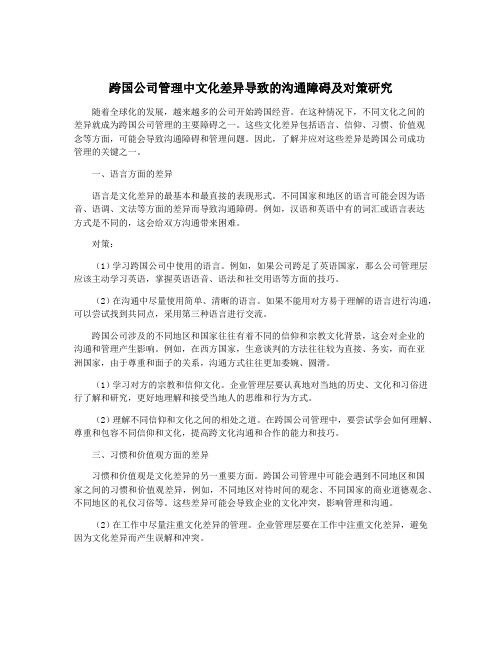
跨国公司管理中文化差异导致的沟通障碍及对策研究随着全球化的发展,越来越多的公司开始跨国经营。
在这种情况下,不同文化之间的差异就成为跨国公司管理的主要障碍之一。
这些文化差异包括语言、信仰、习惯、价值观念等方面,可能会导致沟通障碍和管理问题。
因此,了解并应对这些差异是跨国公司成功管理的关键之一。
一、语言方面的差异语言是文化差异的最基本和最直接的表现形式。
不同国家和地区的语言可能会因为语音、语调、文法等方面的差异而导致沟通障碍。
例如,汉语和英语中有的词汇或语言表达方式是不同的,这会给双方沟通带来困难。
对策:(1)学习跨国公司中使用的语言。
例如,如果公司跨足了英语国家,那么公司管理层应该主动学习英语,掌握英语语音、语法和社交用语等方面的技巧。
(2)在沟通中尽量使用简单、清晰的语言。
如果不能用对方易于理解的语言进行沟通,可以尝试找到共同点,采用第三种语言进行交流。
跨国公司涉及的不同地区和国家往往有着不同的信仰和宗教文化背景,这会对企业的沟通和管理产生影响。
例如,在西方国家,生意谈判的方法往往较为直接、务实,而在亚洲国家,由于尊重和面子的关系,沟通方式往往更加委婉、圆滑。
(1)学习对方的宗教和信仰文化。
企业管理层要认真地对当地的历史、文化和习俗进行了解和研究,更好地理解和接受当地人的思维和行为方式。
(2)理解不同信仰和文化之间的相处之道。
在跨国公司管理中,要尝试学会如何理解、尊重和包容不同信仰和文化,提高跨文化沟通和合作的能力和技巧。
三、习惯和价值观方面的差异习惯和价值观是文化差异的另一重要方面。
跨国公司管理中可能会遇到不同地区和国家之间的习惯和价值观差异,例如,不同地区对待时间的观念、不同国家的商业道德观念、不同地区的礼仪习俗等。
这些差异可能会导致企业的文化冲突,影响管理和沟通。
(2)在工作中尽量注重文化差异的管理。
企业管理层要在工作中注重文化差异,避免因为文化差异而产生误解和冲突。
总之,跨国公司管理中的文化差异可能会导致沟通障碍和管理问题。
企业在跨国经营中如何应对文化冲突

企业在跨国经营中如何应对文化冲突随着全球化的不断深入,企业跨国经营的规模和范围不断扩大,但企业在不同国家地区的发展必然会面对不同的文化背景和文化冲突。
如果企业不能适应和化解这些文化差异和冲突,就会给企业的发展和经营带来大量障碍和风险。
因此,企业需要制订适应性强、系统性好的跨国文化战略以及有效应对的措施,从而实现企业跨越发展和长期竞争优势。
本文将从不同的角度对企业在跨国经营中应对文化冲突的措施进行探讨。
一、了解和尊重目标国家的文化企业在跨国经营中,首先需要了解并尊重目标国家的文化,这包括如何尊重当地文化、为本地员工提供就业机会,尊重当地人的生活方式和消费习惯,落实本国媒体形象,并与当地人和平相处。
这需要企业在开展海外业务之前,首先了解目标国家的文化和价值观,并在企业价值观中加入当地文化内容。
此外,企业可以领导层在当地生活一段时间,体验当地文化习惯,提高文化敏感度、文化理解能力和文化适应能力。
例如,星巴克在中国市场上开展业务时,研究了当地群体的消费风尚和文化习惯,并针对当地风尚推出了一系列符合当地口味和文化特点的优惠活动、菜单和雅致的装潢。
二、培养多元文化人才企业在跨国经营中的文化适应能力依赖于企业员工。
因此,企业需要加强多元文化人才的培养和引进,提高员工文化适应能力和文化融合能力。
企业可以采用以下措施,增强员工的多元文化背景:1.鼓励员工在不同的国家或地区开展业务。
2.针对员工开展文化培训,使员工有更好的文化适应能力,并且了解目标国家的风土人情和文化背景。
3.引进当地员工,提高自身团队的文化融合能力。
三、建立跨文化沟通机制文化差异给企业沟通带来了困难。
因此,企业需要建立跨文化沟通机制,增强自身的跨文化沟通能力。
企业可以采取以下措施:1.使用不同语言的陪同员工和翻译,降低沟通误差。
2.创建文化交流平台,例如:实施员工交流计划和建立社区活动,使员工相互交流,并分享和研究不同的文化习俗。
3.培养当地同事,增强当地员工之间的文化融合能力。
跨国公司如何处理不同的企业文化差异

跨国公司如何处理不同的企业文化差异在如今全球化的商业环境中,跨国公司面临着处理不同企业文化差异的挑战。
企业文化是指组织内部共享的价值观、信念、行为模式和习惯。
不同的企业文化会影响到员工的工作态度、沟通方式和决策过程,因此,在进行合并、收购或拓展业务时,跨国公司应该重视处理不同企业文化差异的问题。
本文将从以下几个方面探讨跨国公司如何处理不同的企业文化差异。
1. 了解差异:首先,跨国公司需要充分了解不同企业文化之间的差异。
这包括了解每个国家或地区的历史、价值观、宗教信仰和社会习俗等方面的差异。
此外,还需要了解不同企业的组织结构、领导风格和沟通方式等内部文化差异。
通过深入了解差异,公司可以更好地应对挑战,避免文化冲突,并取得更好的合作效果。
2. 建立共同价值观:在合并或收购过程中,跨国公司应该努力在不同企业之间建立共同的价值观。
这可以通过双方派遣代表团队进行交流和合作,以建立互信和理解。
共同的价值观有助于加强团队合作,提高员工的工作动力和满意度。
3. 优化沟通方式:跨国公司应该尽可能采用多种沟通方式,以满足不同企业文化的需求。
例如,在多元文化团队中,可以运用非语言沟通(如图片、图表)来弥补语言障碍。
此外,使用现代技术工具,如视频会议和在线协作平台,有助于提高跨文化沟通的效率和效果。
4. 建立培训计划:为了提高员工对不同企业文化的敏感度和适应能力,跨国公司应该开展跨文化培训计划。
培训可以涵盖各种主题,如跨文化沟通、文化智商和领导多元化等。
通过培训,员工可以更好地了解不同文化之间的差异,并学习如何在跨国工作环境中更好地互动和合作。
5. 创建多元化的团队:跨国公司应该鼓励多元化的团队合作。
多元化的团队可以促进不同文化间的交流与学习,同时也能打破单一文化内部的局限性。
此外,组建跨文化的领导团队也有助于公司更好地管理和应对不同企业文化的挑战。
6. 建立共享平台:为了加强不同企业间的合作和交流,跨国公司可以建立共享平台。
近三年由于文化因素产生劳动冲突的案例

近三年由于文化因素产生劳动冲突的案例近三年来,由于文化因素产生的劳动冲突案例屡见不鲜。
这些案例涉及各个行业和地区,反映了不同文化背景下的价值观冲突、沟通障碍以及管理方式的差异等问题。
以下将以几个具体案例为例,探讨近三年来由于文化因素引发的劳动冲突。
一、跨国公司中的文化差异引发的劳动冲突在全球化进程中,跨国公司面临着不同国家和地区之间的文化差异。
这些差异往往会导致员工之间的沟通障碍和价值观冲突,从而引发劳动冲突。
1. 案例一:美国公司在中国设厂引发工人罢工某美国汽车零部件制造公司在中国设立了一家新工厂,雇佣了大量中国本土员工。
然而,在生产过程中,由于美式管理方式与中国员工习惯存在巨大差异,导致了员工对工作强度、加班和薪资等方面存在不满。
这些不满情绪积聚到一定程度后爆发成为一场罢工事件,严重影响了公司的生产和声誉。
2. 案例二:日本公司在印度遭遇员工抗议某日本电子产品制造公司在印度设有一家分厂,由于日本和印度之间的文化差异,公司的管理方式与员工期望存在较大冲突。
员工对于严格的纪律要求、长时间加班以及缺乏参与决策的机会感到不满。
这些不满情绪最终演变成了一场员工抗议活动,要求改善工作条件和提高福利待遇。
二、行业内部文化差异引发的劳动冲突除了跨国公司之外,同一个行业内部也存在着不同企业之间的文化差异。
这些差异往往会导致企业间竞争加剧,并引发劳动冲突。
1. 案例三:传统企业与互联网企业之间的文化冲突近年来,传统企业与互联网企业之间出现了明显的文化差异。
传统企业注重稳定性、层级管理和传统价值观,而互联网企业则更加注重创新、平等和开放性。
这些差异导致了两者之间的竞争加剧和劳动冲突的产生。
在零售行业,传统实体店面对电商的崛起感到压力,而电商企业则面临着传统企业的抵制和不公平竞争指责。
2. 案例四:国有企业与民营企业之间的文化冲突在中国,国有企业和民营企业之间存在着明显的文化差异。
国有企业注重政府指导、稳定性和集体主义价值观,而民营企业则更加注重市场导向、灵活性和个人价值观。
文化冲突案例

文化冲突案例文化冲突是指由于不同文化价值观念、习俗和传统等差异而导致的矛盾和冲突。
在全球化的今天,不同文化之间的交流和碰撞日益频繁,文化冲突案例也时有发生。
下面,我们将通过几个案例来探讨文化冲突的表现形式和解决方法。
案例一,跨国合作中的文化冲突。
在跨国公司的合作中,不同国家的员工往往会因为文化差异而产生冲突。
比如,美国的商务文化注重效率和结果,注重直接沟通和表达个人观点;而中国的商务文化则注重人际关系,喜欢通过间接方式表达观点,讲究面子和礼节。
当美国员工要求中国员工按照时间表完成工作时,中国员工可能会觉得被压迫和不尊重,从而产生矛盾。
解决这种文化冲突的方法,就是双方要增进相互理解,尊重对方的文化差异,寻求双赢的合作模式。
案例二,移民社区中的文化冲突。
在移民社区中,不同文化之间的冲突也是常见的。
比如,一个华人移民社区中的父母可能会希望子女继承传统的价值观念和行为习惯,而子女则受到了当地主流文化的影响,有着自己的生活方式和观念。
这种文化冲突可能会导致代沟和矛盾。
解决这种冲突的方法,就是在尊重传统文化的基础上,给予子女更多的自由空间,让他们在传统文化和主流文化中找到平衡点。
案例三,国际旅游中的文化冲突。
在国际旅游中,游客往往会因为不了解当地文化而产生冲突。
比如,一些西方游客在访问东方国家时可能会因为不了解当地的礼仪习惯而得罪当地人,比如穿着不得体、言语冒犯等。
这种文化冲突可以通过加强旅游宣传和教育来解决,让游客在出行前对目的地的文化有所了解,尊重当地的风俗习惯。
总结:文化冲突是多元文化交流中不可避免的问题,解决文化冲突的关键在于增进相互理解和尊重,寻求双赢的合作模式。
只有通过相互包容和尊重,不同文化才能和谐共处,实现共同发展。
希望通过以上案例的分析,能够更好地认识和理解文化冲突,并在实际生活和工作中更好地处理文化冲突,促进文化交流和融合。
跨国公司的文化冲突案例分析

跨国公司的文化冲突案例分析1. 案例背景在当今全球化的商业环境下,跨国公司在各个国家展开业务已成为常态。
然而,在不同国家之间存在着各种文化差异,这些差异可能导致跨国公司在管理和运营过程中遇到各种文化冲突。
本文将以一个具体案例来分析跨国公司文化冲突的发生原因、影响和解决方法。
2. 案例描述假设ABC跨国公司在过去几年内扩张至亚洲市场,进入与其总部所在国国家文化截然不同的市场。
由于缺乏针对当地文化的了解和适应能力,ABC公司在与当地员工和合作伙伴的沟通和协作中遇到了一系列的问题。
3. 文化冲突的原因3.1 价值观差异:不同国家具有不同的价值观念,比如对权力、组织结构、个人和集体的看法。
ABC公司由于没有对当地文化进行充分了解,在决策和管理方式上与当地员工存在不一致,导致了潜在的冲突。
3.2 沟通障碍:语言和沟通方式的差异也是文化冲突的重要原因之一。
ABC公司的管理层和当地员工之间存在语言障碍,无法进行有效的沟通和理解,影响了工作效率和团队合作。
3.3 习俗和礼节差异:在亚洲地区,很多习俗和礼节对于企业的日常运营和商务往来具有重要意义。
ABC公司由于对当地文化的缺乏了解,可能会在交往中犯下文化陷阱,给合作伙伴留下不好的印象,进而影响业务合作。
4. 文化冲突对公司的影响4.1 业务受阻:文化冲突可能导致工作流程和沟通受阻,影响到公司业务的顺利进行。
员工之间的合作和团队的协调也可能受到影响,进一步阻碍公司的发展。
4.2 员工离职和人才流失:由于文化冲突的存在,员工可能感到无法融入公司文化,导致员工流失。
这不仅造成了人才流失,还增加了公司在寻找人才和培训上的成本。
4.3 影响品牌形象:跨国公司在当地的形象和声誉是其业务成功的重要因素之一。
文化冲突可能导致公司被误解或产生偏见,进而影响公司在当地市场的形象和品牌价值。
5. 解决文化冲突的方法5.1 文化培训:为了避免文化冲突的发生,跨国公司应该提供适当的文化培训,帮助员工了解和适应当地文化。
跨文化管理中的文化差异与冲突解决

跨文化管理中的文化差异与冲突解决跨国公司的出现和企业国际化的趋势,促进了全球经济一体化的进程。
在这个过程中,跨文化管理成为企业文化管理的重要组成部分。
实现跨文化管理需要深入了解文化差异并寻找解决文化冲突的有效方法。
一、文化差异分析1.语言差异语言差异是跨文化交流中最大的阻碍之一。
企业需要了解员工和客户的语言背景,尽可能提供多种语言沟通渠道,加强员工语言培训,以便更好地进行企业管理和商业交流。
2.礼仪差异礼仪是各国文化的重要组成部分。
在商业场合,要注意每个国家的礼仪差异。
例如,在中国,名片是一项非常重要的商务礼仪,用手接过名片并看一眼是一种尊重的表现;而在美国,这种做法可能被视为轻率。
对不同国家的礼仪差异进行了解和尊重有助于维护良好的商务关系。
3.价值观差异不同国家和不同文化背景下的人们有自己独特的价值观和行为准则。
例如,某些地区的人们认为家庭是最重要的,而在另一些地区,个人主义更为普遍。
企业需要注意这些差异,根据当地的文化情况,制定相应的企业文化和管理策略。
二、文化冲突解决1.尊重多元文化企业应尊重不同的文化差异,采取多元文化管理的策略。
这意味着,企业应该容忍员工可能存在的文化冲突,并寻找解决问题的方法。
2.加强沟通和培训在企业管理和商业交流中,良好的沟通能力非常重要。
企业应该加强员工的语言培训,聘请跨文化交流专家,以便更好地了解不同国家和文化的企业文化和管理策略。
3.与当地企业合作企业可以寻求与当地企业的合作,通过合作可更好地了解当地的文化、政策和法律。
并且,在与当地企业的合作中积累经验,提高跨文化管理和解决文化冲突的能力。
结论跨文化管理需要充分了解文化差异并寻找有效方法解决文化冲突。
随着全球化进程的加速,文化差异和冲突将更加常见。
通过尊重多元文化,加强沟通和培训,与当地企业合作,企业可以更好地进行跨文化管理。
- 1、下载文档前请自行甄别文档内容的完整性,平台不提供额外的编辑、内容补充、找答案等附加服务。
- 2、"仅部分预览"的文档,不可在线预览部分如存在完整性等问题,可反馈申请退款(可完整预览的文档不适用该条件!)。
- 3、如文档侵犯您的权益,请联系客服反馈,我们会尽快为您处理(人工客服工作时间:9:00-18:30)。
跨国公司中的文化差异与冲突a study of cultural differences and cultural conflicts inmultinational corporationsabstract: the 2008 global economic crisis offers an unprecedentedly golden chance to the chinese national enterprises that are desire of taking over overseas big potatoes. nevertheless, the tragedies of cross-border acquisition and merger tie much closer to business world than the comedies. in fact, the main reason of the failure is the dearth of global leadership and intercultural communication competence among domestic entrepreneurs and management team members who are also short of experience of overseas business operation, which sets huge obstacles for the domestic corporations to handle multinational corporation syndrome (mcs)loomed shortly after the fledging period ofcross-border acquisition and merger. these paper analyses the relationship between culture and management, uncovers the real cause of multinational corporation syndrome一一cultural differences, and proposes golden time to address multinational corporation syndrome.key words: cultural differences, cultural conflicts,multinational corporations1.introductionthe global economic crisis in the late of 2008 has brought catastrophe to a lot of well-established multinationals whose current business running status stays at stake. in order to fight against financial deficit, the previous ever bright giants cannot but decide to sell assets as well as subsidiaries. consequently, it offers an unprecedentedly golden chance to the chinese national enterprises that are desire of taking over overseas big potatoes. on the one hand,the domestic corporations have been developed at a dramatic speed with abundant capital reserves in the wake of china’s access to wto, which guarantees the finical capability of carrying out mergers or acquisitions. on the other, the local companies would not only level up competitiveness via absorbing state-of-the-art technology from overseas ones but also pave the way for launching thrilling campaigns on the international markets. nevertheless, the tragedies of cross-border acquisition and merger tie much closer to business world than the comedies. in fact, the main reason of the failure is the dearth of global leadership and intercultural communication competence among domestic entrepreneurs and management team members who are also shortof experience of overseas business operation, which sets huge obstacles for the domestic corporations to handle multinational corporation syndrome(mcs)loomed shortly after the fledging period of cross-border acquisition and merger.2.intercultural integration in multinational corporation syndromebastine&ven (1986) and olie (1995) put forward multinational corporation syndrome (mcs). it means that newly merged and acquired cross-border companies would encounter a lot of confusion, barriers, and frictions during corporation communication right after taking-over procedures.olie (1995) maintains the rate of successful merger or acquisition floats from 40% to 50% . in his survey of 8000 newly acquired and merged companies, muller (1998) states that only 15070 of the companies bear sound outcome, whereas these successful companies do not yield direct profits in the coming few years. similar to their surveys, jack prouty,global partner of kpmg, displays his study of “70/70”concerning corporation acquisition and merger. it shows that 70% of the companies fail to realize its anticipated business value, and 70% of the failure occurs during the process ofcorporation integration. in his view point, prouty owes cultural conflicts and improper cultural integration to the failure. what’s more, a survey of fortune 500 ceos unearths that 70% of cross-cultural mergers and acquisitions do not yield ideal outcome and the failure of cross-border mergers and acquisitions is attributed to the unanticipated problems in dealing with people, including corporation governance and staff welfare. moreover the survey shows 50% of managers choose to leave the company within one year after taking-over.as far as the author is concerned, the failure of management in multinationals not only lies in the divergence of management concept and manners but also rests with the difference of culture, as the previous analysis of the culture and management mentioned. in fact, setting corporation relationship between strategic objectives,making final decisions, allocating human resource, and expanding public relations are all administrated by human beings. people from different culture would share various viewpoints in business running, which is displayed on diverse performance of communication. staff members would be more likely to misunderstand others’remarks and behavior in such assorted culture backgrounds. if not settled properly, thetiny conflicts would be upgraded into skirmishes and even huge disasters. therefore, managing cross-border corporations essentially demands intercultural knowledge and practice.3.merger stages in intercultural synergyzhuang enping (2005) divides the period of cross一border acquisition and merger into two stages, say, the pre-merger stage and the pro-merger stage, according to his research on the diagnosis, analysis, and resolution of multinational corporation syndrome.during the pre-merger stage, both sides initiate negotiation considerably centered on the maximized economic interests which they can achieve.pro-merger stage is the time when both sides start to perform duties and own right after signing the contract. at this time, the newly-combined company begins to run. personal factors have been taken as the paramount things to harness business operation and daily communication since the both sides have identified and ratified the agreement on financial interests at the pre-merger stage. it is true to see personal factors under multi-cultural workplace as cultural factors. global workers could solve communication conflicts according to the newly-built corporation culture which actually atfirst is well-recognized by the total staff members. in other words, cultural factors based on the culture synergy play crucial roles at pro-merger stage. hence, it is the golden time for corporation development at this period.according to the survey by kearney inc., it mainly specializes in analyzing ratios of risk during corporation merger periods. the period of corporation merger is put into three divisions, stage of scheming goals and seeking partner,stage of negotiation and contract signing, and thepost-merger stage from the feedbacks.according to the data, 30% of interviewees hold the idea that searching an ideal partner acts as the riskiest circle;17% of interviewees find that the period of meeting and negotiation is the most perilous one; and the remaining 53% of people firmly view that post-merger stage is full of uncertain factors.it manifests that both zhuang’s research and kearney’s survey underscore that the stage after taking-over procedures, namely, post-merger stage, is the most crucial period in cross-cultural mergers and acquisitions, when culture outweighs other factors in daily business operations. now that the post-merger stage is so of great important,intercultural integration is highly preferred at this period in order to overcome multinational corporation syndrome.4.suggestionsas far as the author is concerned, it is strongly recommended that global ceos should design and carry out intercultural synergy as early as possible in order to fuel the integration of various cultures and reduces conflicts. it is a clever idea to add the plan of cultural merger on the meeting agenda, providing the two parts regard the other side as the sole cooperative partner and final signing contract is under preparation. generally speaking, the more early the cultural integration takes place, the more quickly the international staff performance well. in addition, early cultural integration helps staff members get more easily accustomed to the new environment in the wake of corporation acquisition and merger.reference:1、olie, r. l., 1996, european transnational merger [m],maastricht university press;2、varner, i. & beamer, l., 2005, intercultural communication in the global workplace [m], new york: mcgraw hill;3、schein, e. h., 1985, organizational culture and leadership [m], san francisco: jossey bass;4、庄恩平.跨国公司综合症诊断、分析与对策[j]. 管理科学杂志,2005作者简介:石雪(1988.11-),女,汉族,山东省泰安市人,在读研究生研究方向为应用语言学.。
